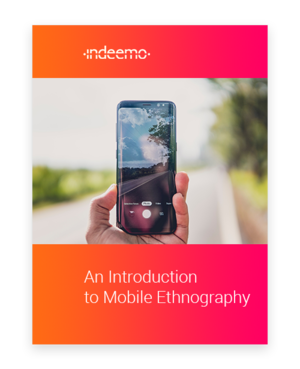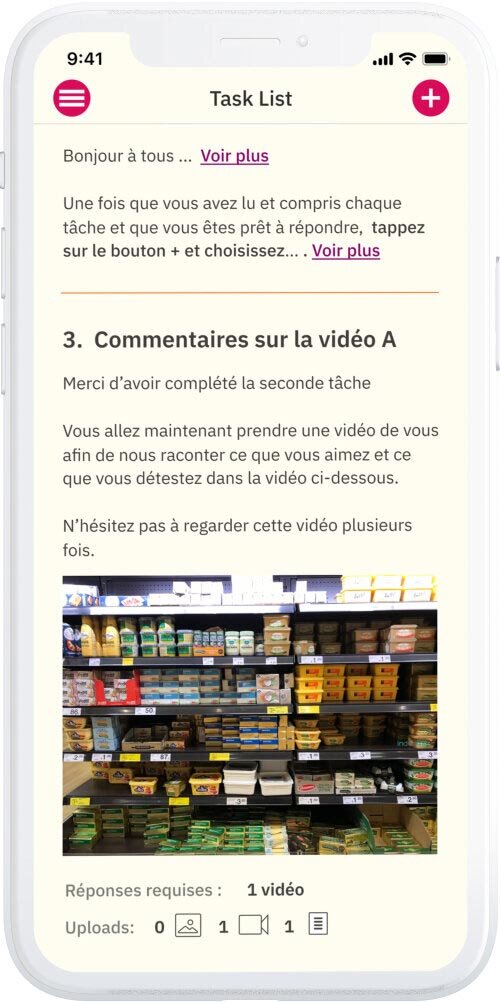Mobile Ethnography White Paper
Learn how Mobile Ethnography can supplement your research projects and generate richer contextual insights for your brands.

Mobile ethnography is a remote qualitative research methodology that is growing in popularity as a means to generate rich, in-the-moment, contextual insights. The methodology can be used as a standalone methodology or to supplement quantitative data and analytics.
One of the attractions of the remote approach is that it enables researchers to generate rich in context data from respondents. Using their smartphones respondents complete tasks in the context of their everyday lives at the very moment they are making decisions or doing specific activities.
This gives remote researchers a unique perspective as to how they behave and make split-second decisions.
Think of it as a ‘periscope’ into reality.
Another attractive element of the approach is that increasingly it can be used to generate insights from respondents across a range of different geographies on a much more cost-effective basis than has traditionally been the case.
So if you are new to undertaking remote, multi-market, mobile ethnography this post details some of our top tips to ensure your research project is a success.
The following steps detail how you can undertake online qualitative research using Mobile Ethnography across multiple countries and multiple markets.

Recruitment for remote qualitative research projects using Mobile Ethnography is the same as recruiting for a Focus Group or for an in-depth interview.
The recruiter is the same. The screener is essentially the same: all you need to add is the specs for smartphone operating systems. The fees you will pay your recruiter are typically the same.
Here at Indeemo, we work with a network of recruiters internationally, so if you do not have a recruiter in the local market, reach out to us and we can make some introductions.
Typically it will take Recruiters 2 weeks from receipt of the screener to being able to provide you with a list of respondents for your Mobile Ethnography project.
Your recruiter will prepare a screener for you. Chances are, you will agree on this with your client in their local language and your recruiter will then have the resources in house to translate this for the local market.
Firstly, the screener will be translated and then published by the recruiter. As respondents opt-in, your recruiter will then manage the process.
It is essential that your recruiter “human screens” the respondents by calling them or doing a quick Skype call. The more you screen your respondents, the better the outcome.
Incentives vary considerably depending on the market. In our experience, the US is the most expensive market to incentivise respondents in. Privacy-conscious markets such as Germany can also be more expensive than other countries. Incentives across the main European markets are typically the same.
There is also a wide variety in South East Asia, with China being the most expensive. We are happy to share indicative benchmarks if you have a project to discuss. We always, however, defer to the advice of the recruiter in each local market.
As a benchmark, a 7-day remote qualitative research or Diary Study using Mobile Ethnography will typically cost you the same as a 2-hour Focus Group would. The amount of the incentive is similar to an in-person qualitative research approach.
Our advice is to avoid panels where possible. Sure, the recruitment will be cheaper and the incentives likely less, but the quality of respondent and engagement levels are extremely poor compared to a well-screened, qualitative recruitment process.
It can be daunting trying to navigate a myriad of languages. Modern mobile ethnography platforms can support tasking and moderation in any language.
In most projects we support, the main consultancy driving the project will recruit a series of freelance moderators in each market. These moderators are excellent. They speak the language, can translate all your task lists and discussion guides and when it comes to moderation, they know the cultural nuances and will provide excellent support.
Again, if you do not have a network, we can make some introductions for you.

You should typically budget one week of lead time (two preferably on complex projects) for setting up a multi-market research project. The following needs to be arranged and coordinated to ensure everything goes seamlessly:
Preparation of the Discussion Guide / Task List. This is first done in English. You send your first draft to Indeemo, we preview this and schedule a screen share to advise you on how best to optimise your discussion guide / Task List to work best on mobile. Allow 2 days to draft the first version with your client, one day to schedule a consultation with Indeemo and 1 day to revise.
Once this is signed off with the client, you submit the project to Indeemo and we set up the project so you can preview it on the platform. Allow 1 day for this.
Once the project is set up on Indeemo, we arrange a training screen share and give you a demo for everything you need to understand. This will take 1 hour max.
Allow yourself 1 day to preview your tasks in the platform and make any final edits.
You then forward your final task list to each moderator (or the recruiters in each market can also do the translation. Allow 1 day.
Indeemo then sets up the remaining markets and schedules a training session with all your local moderators. (Allow 1 day)
Once your moderators are trained and ready to go, they can then invite the respondents to take part in the project.
Getting respondents up and running is easy.
Indeemo’s app is similar to a slimmed-down version of Instagram or Facebook and as a result, respondents are instantly familiar with the UX. It’s easy and it’s fun to use.
Respondents are then given tasks and they complete these tasks by uploading photos, videos, screen recordings or text responses throughout the fieldwork.
Typically, fieldwork lasts up to 1 week and respondents can spend anything from 10 - 30 minutes per day completing their tasks.
During this time, they will take you into their lives and their homes and you will get to walk in the shoes of many respondents across multiple markets without ever leaving your desk. It is amazing how powerful it is to be connected with some many cultures at once.
Your local moderators will ensure they are active and engaged.
All of the posts from respondents are instantly uploaded into the Indeemo dashboard and your moderators can comment and probe what the respondents upload.
Think of moderation on Indeemo as being like a 1-1 Facebook comment style interaction between your moderator and each respondent. Because it’s private and one to one, respondents are given a safe space to truly open up and bring you into their lives enabling you to elicit rich insights.
As respondents and moderators interact, you can log in to the Indeemo dashboard and experience the research as the fieldwork unfolds.
Flexible permissions mean moderators in each market can only interact with the respondents they are linked to. You, and your client, however, can log in to the dashboard and see all markets using a single login. You thus get a seamless, global perspective on your research project.
You can log in with researcher access which allows you to interact with respondents if you wish. Your clients can also be given observer logins to be able to view content without being able to interact.
Modern Mobile Ethnography platforms contain a suite of powerful functionality to make it easy for you and your moderators to analyse the data and prepare your reports:
Powerful filters to make it easy to search the data
Automated video transcription to turn videos into searchable transcripts in minutes
Automated keyword analysis tools to quickly help you spot trends and themes in both text and video-based data
Tagging and coding tools to organise and code the data
Collages, Timelines, Keyword clouds give you multiple lenses into the same data.

The benefits are significant:
Cost
Compared to flying researchers all over the planet, the cost of doing multi-market, remote qualitative research is disruptively efficient.
Reduction in Travel
Projects can be carried out with no travel. Apart from the saving in cost, time and the benefits to the environment, this methodology means that you can run projects literally from your home office if needed.
Speed
It’s faster. Compared to doing in-person ethnography in each market, you can run multiple markets at once which drastically cysts down the time from fieldwork to debrief and makes you more agile and responsive to changing conditions
Scale
By being able to tap into local expertise and manage multiple concurrently, you can significantly increase your reach and cover more markets at a cost that is lower than traditional approaches.
1 Week Versus 1 Hour
Unlike face to face approaches where you need to garner all of your insights in a restricted 1-2 hour window, remote qualitative research using Mobile Ethnography allows you to walk in the shoes of respondents for 1 week.
Richer Context
The more rapport you build, the more they will open up and bring you into their lives in a way that is previously impossible using traditional approaches.

We have supported hundreds of multi-market projects around the world. It’s becoming a core use case for us. If you’d like to chat further about how Mobile Ethnography can help you do remote qualitative research across multiple markets, please get in touch now and one of our Strategists will be in touch.
If you’re interested in running a project over the coming months, please get in touch ASAP to allow adequate time for strategy, setup, and support.



Learn how Mobile Ethnography can supplement your research projects and generate richer contextual insights for your brands.
